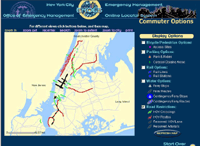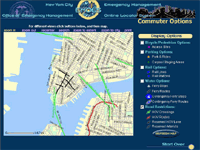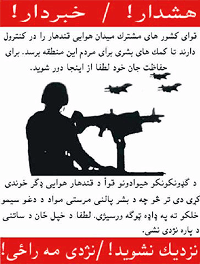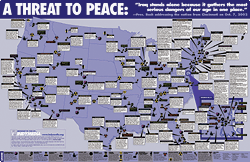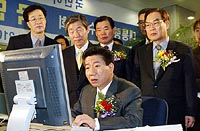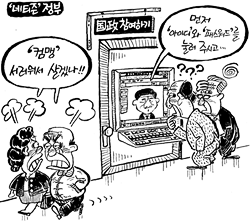Found 3050 matches from 1,400 records in about 0.0837 seconds for Write or On or Stomach.
“New York City averted a public transit strike recently, saving commuters and residents a metropolitan-size headache of getting around. But if it had come to that, the city was ready to help idle people find their way.
A week before the scheduled strike, the city’s Office of Emergency Management, the Department of Information Technology and Telecommunications, and Frankfort, Ky.-based PlanGraphics Inc. designed and developed an interactive online map that enabled users to view various alternative transportation options and vehicular restrictions.
The application, which took about a half-day to design and a week to develop, was activated from Friday evening, Dec. 13, to Monday noon, Dec. 16, the deadline for the strike, said Mike Wiley, a project manager for PlanGraphics in New York City. During that time, users viewed more than 70,000 custom maps with a peak of about 6,000 maps served up Sunday evening. Although the application was subsequently deactivated, it’s available should a similar situation occur in the future.
The system can highlight bicycle and pedestrian access sites, carpool staging areas, rail lines and stations, ferry stops and routes, including contingencies, as well as carpool-only routes and other road restrictions.
The application is based on the city’s Emergency Management Online Locator System, which allows New Yorkers to find hurricane evacuation routes or cooling centers during a heat wave.
PlanGraphics, which has a seven-year working relationship with the city, also helped develop an online map of the area around the World Trade Center shortly after the Sept. 11, 2001, terrorist attacks. Sometimes twice daily, the company or the city would update what areas were accessible by motor vehicles or pedestrians in the area and provide other information.
The company is also planning to update the city’s “My Neighborhood Statistics” application, which allows users to view 14 selected performance statistics about their community, such as air and noise complaints, structural fires, infant mortality, clean sidewalks, felonies and certified teachers. By the end of January, the system, which went live in September 2002, will show 80 different metrics.
The city also recently awarded PlanGraphics a three-year, $15.4 million contract to continue to develop and upgrade the city’s GIS data repository, and provide greater access as well as more customized applications for the public and city agencies.”
Other non-interactive maps were posted, but the site vanished from the Web as quickly as it was posted.
MapQuest has driving instructions, Staphangers .org used to have a working subway route finder, and the Department of Transportation has PDF of NYC bicycle routes, but I’ve not found anything that ties together NYC’s many transportation alternatives into one online application.
In a struggle that shook the City, the Transport Workers Union stood up to the Mayor’s intimidation and successfully fought cuts. They also pushed the City into developing the most comprehensive New York City route finder I’ve seen. The screen shots I found indicate that the target audience were those who work in lower Manhattan and Wall Street, but such a tool would be useful for everyone — and would indicate which neighborhoods are underserved. I hope they put it back online, with subway and bus info added.
Update, 9/12/2003: The lack of a integrated route finding system in NYC has prompted one New York City resident to build his own. It needs work, but integrates bus and subway connections quite nicely.
“The Partnership of Nations has secured the Qandahar Airport to ensure that Humanitarian Aid will reach the people of this area. For your own safety stay away.”
Leaflet War Rages in Afghan Countryside
“The war in Afghanistan is not just about bombing mountain hide-outs, it’s also about getting a message out. The result is a leaflet war that has littered the Afghan countryside with thousands of pieces of paper.
On one side are the United States and its allies, who use pamphlets with mugshots of fugitives and pictures of Taliban abuses to warn coalition enemies that there is no escape.
On the other side are the Taliban, al-Qaida and renegade rebel leader Gulbuddin Hekmatyar, whose much more prolific flyers warn foreign soldiers they are targets, or urge Islamic faithful to rise up against them in holy war.
The anti-American pamphlets are called ‘night letters,’ secretly circulated and strewn by the hundreds in towns, villages and countryside. Within the last few weeks, they turned up in the capital of Kabul for the first time.”
The AP story depicts much of the propaganda war centering on women’s bodies — U.S. forces shown searching a young girl vs. a member of the Taliban shown beating a woman.
However, of the U.S. flyers shown here, some are instructional — tune to this radio station, those yellow things are food packets — but most simply hawk moral platitudes and cash money rewards.
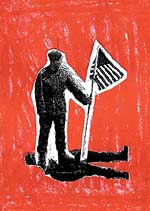
“ANTI-WAR.US is dedicated to the free distribution of anti-war graphic material.
As creative individuals trained in methods of mass-communication, we can make a real difference by providing clear anti-war messages.
All materials on this site are created voluntarily and distributed free to activists around the world.”
A nice idea. I’m kicking myself for not thinking of it. Will send one of my own poster ideas shortly.
I do hope they will excercise some curatorial judgement, though. I’m a long-time admirer of Charles Wilkin’s design work. I’ve even used one of his fonts, but painting President Bush in the same league as Stalin and Hitler does not help the credibility of your cause.
via American Samizdat. Image above by M. Musri, Fabrica.
“The Indypendent - the monthly newspaper of the NYC-Indymedia Center proudly presents ... A Threat to Peace - a handy poster-sized color map of U.S. terrorist infrastructure.
Whether you’re a budding weapons inspector or just a trivia buff, A Threat to Peace can give you the scoop on nuclear manufacturing facilities, chemical and biochemical weapons facilities, weapons manufacturers, nuclear testing and launch sites, and much, much more.”
Download the poster or order one.
Points of interest include:
- Chemical Weapons
- Domestic War Criminals
- Imported War Criminals
- Private Mercenary Companies
- Military Sites
- Biological Weapons
- Nuclear Weapons
- Terrorist Training Camps
- Rest & Recreation
- Militarization of Space
- Major Weapons Makers
- Universities, Policy Institutes & Think Tanks
- Nuclear Facilities
- Ballistic Missile Defense
In 1969, Arkansas Senator J. William Fulbright, announced the results of his investigation into the Defense Department’s lavish spending on propaganda and self-promotion during the Vietnam War.
Mitchell Hall writes in Unsell the War: Vietnam and Antiwar Advertising, (Historian, Autumn 1995):
“From 1959 to 1969, the Pentagon’s public relations expenditures increased 1,000 percent to an acknowledged $27.9 million, a figure Fulbright called ‘conservative.’ With this financing and a full-time public information force of 2,800 people, the military enjoyed overwhelming access to the public. In 1968 the navy and marines sent over 2.8 million news releases to 12,000 print and broadcast media outlets, in 1969 armed forces performances ranging from musical groups to aerial demonstrations played to audiences estimated at 20 million, and over 360 commercial and educational television stations used the U.S. Army-produced TV show ‘Big Picture.’ The potential influence on public opinion and foreign policy was enormous.
U.S. presidents from Harry Truman to Richard Nixon had also tried to persuade the public that events in Indochina demanded a U.S. military presence. Their efforts initially succeeded, but by the late 1960s millions of Americans had publicly demonstrated their rejection of a policy that had brought increasing sacrifice, destruction, and stalemate. Nixon’s Vietnamization policy, which gradually removed U.S. ground troops but escalated the bombing, partially defused antiwar activity by early 1971. Decreasing U.S. casualties convinced many people that the war was winding down. Although massive public demonstrations occurred less frequently than before, citizens in the early 1970s continued to work to end the war in numerous and creative ways.
On February 23, 1971, CBS broadcast the documentary “The Selling of the Pentagon.”
“Reiterating many of the points addressed in Fulbright’s report, this hour-long program examined the Defense Department’s public relations efforts that, in addition to recruiting volunteers and providing information, marketed a specific interpretation of the Vietnam War and the cold war to the U.S. public....
The military establishment annually arranged hundreds of public contacts that included shopping mall exhibits, Green Beret hand-to-hand combat demonstrations, and tours by flight teams such as the Thunderbirds. In clear violation of regulations, a select group of colonels avidly promoted the U.S. presence in Vietnam in speeches they gave around the country. The Defense Department also provided weekend guided tours of military installations to VIPs, who could observe war games from a grandstand and personally fire tank guns and artillery.
Films also propagated the military’s ideology. The Pentagon cooperated with Hollywood producers who portrayed the military favorably and had celebrities and journalists narrate some of its own movies....
The Defense Department achieved its widest exposure through the news media. Daily briefings to the national press yielded only carefully selected information from the Pentagon’s public relations division. The armed forces also maintained their own media arm, producing over two million press releases each year. Local newspapers generally snapped up uncritically this flood of news about the awarding of medals and promotions. Military television crews provided combat footage to supplement network coverage but often staged the action. Similarly military officials frequently held pre-interview briefings with soldiers in the field to ensure a standard acceptable story before allowing network TV reporters access to them. CBS questioned the impact on a democratic society and free press of a vast military information system that portrayed violence as glamorous, advertised expensive weapons like cars, and presented biased opinion as fact.”
Ira Nerken, a junior at Yale University studying political science, missed the initial broadcast of ”The Selling of the Pentagon” but read about the controversy it provoked. He decided that the war could be ‘unsold’ to the American public. Print ads had occasionally appeared in leading newspapers, and ad hoc groups produced some radio and television spots, but the advertising world had never been tapped on a large scale.
After discussing his ideas with an instructor at Yale, the instructor introduced him to David McCall, president of LaRoche, McCaffrey & McCall, an ad agency in New York. McCall and James McCaffrey, the agency’s chair, quickly organized a team that produced a poster and letter of explanation seeking support for a campaign to unsell the war. These were sent to 80 executives in 60 agencies.
The initial poster featured a drawing of the Pentagon and the headline, “Help unsell the war.” It read:
“C.B.S. recently devoted an hour to documenting the enormous advertising and public-relations job the Pentagon has done to sell the American public its version of the war. A group of students and faculty at Yale University are asking the men and women of the advertising agency business who disagree with the Pentagon’s version of the war to create advertising in all forms that will help unsell the war.”
The letter closed:
“Needless to say, we are not interested in cheap, superficial, anti-American work, we are interested in thoughtful and honest advertising, created by people who love their country.
I hope you will agree with me that this is a vital contribution which our business can make. If you do not agree, I can understand that, too. But the Pentagon’s side of the story has been ably and massively told. Ours has not.”
 Interested ad executives were invited to briefing at Yale University on April 3, 1971.
Interested ad executives were invited to briefing at Yale University on April 3, 1971.
“Over two hundred New York advertising people attended the early April briefing at Yale’s law school auditorium. Paul Warnke, former assistant secretary of defense, and Morton Halperin, former deputy assistant secretary of defense, explained Nixon’s Vietnam policies, and both urged setting a deadline for total withdrawal of U.S. troops. A representative of Vietnam Veterans Against the War discussed war crimes and problems veterans faced. A member of Concerned Asian Scholars described corruption within the Saigon government and the spreading antiwar feeling in South Vietnam. A person from the Herbicide Assessment Commission to South Vietnam showed slides of defoliation and crop destruction, and a former ABC correspondent in Vietnam detailed the strained relationship between the press and the military. Perhaps the most influential speaker was Milton Rosenberg, professor of social psychology from the University of Chicago. He identified the constituencies most ambivalent about the war and the arguments most likely to turn them against it: the deaths of U.S. troops, the economic consequences for the United States, and the creation of national discord.”
After the briefing, the attendees were asked to produce ads to be reviewed on May 1 by a panel that included Kingman Erewster, president of Yale; Mort Halpern, former Deputy Assistant Secretary of Defense; Dr. Edwin Reischauer, former Ambassador to Japan, and Gen. David M. Shoup of the United States Marine Corps (retired.) The panel would evaluate the ads and eliminate those that were inaccurate, unfair, or inferior.
On Memorial Day, May 31, the ads and commercials were to be displayed and distributed to the media to run as a public service.
Over 300 writers, artists, directors, and producers from nearly 50 ad agencies contributed an estimated $1 million of time and expenses. As of June 8, 1971, 125 print ads, 33 TV commercials and 31 radio spots had been produced. Given the expense of reproducing the ads, only a handful were sent to media outlets.
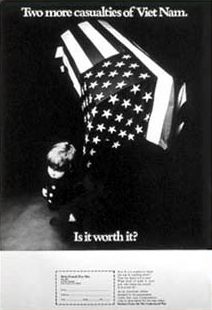 Though the Committee never did convince the major broadcast networks to air the ads, over 100 TV stations and 350 locally owned radio stations around the U.S. did run the spots. During the summer of 71, Nerken was able to arrange free time on 285 billboards around the country. Many of the ads urged people to elect representatives who would vote to end the war by the end of the year.
Though the Committee never did convince the major broadcast networks to air the ads, over 100 TV stations and 350 locally owned radio stations around the U.S. did run the spots. During the summer of 71, Nerken was able to arrange free time on 285 billboards around the country. Many of the ads urged people to elect representatives who would vote to end the war by the end of the year.
“With its attention focused on production rather than marketing, Unsell encountered additional problems inherent in the campaign. It lacked a built-in constituency or the organizational resources to conduct a national distribution effort. Local media felt little pressure to run ads offered by mail from New York. The result was a relative lack of success in getting messages on the air and in print. Because many ads focused on U.S. casualties, the sell became harder as Vietnamization brought more U.S. troops home in favor of an escalated air war, diluting one of the Unsell campaign’s central themes.”
In 1972, the expense and demands of the campaign ultimately led to its transfer to Clergy and Laymen Concerned, the nation’s largest religiously oriented antiwar organization. The focus of ad production also shifted from New York City to Hollywood. The CALC’s network of local chapters were also able to decentralize the task of contacting local media for free time and space. National organizations such as the American Friends Service Committee, Another Mother For Peace, and the Fellowship of Reconciliation also urged their members to get involved in the campaign.
In addition to the decline in U.S. casualties, the ongoing financial burden of the campaign and the 1972 presidential election slowed the momentum of the project which ultimately ended after the reelection of President Nixon and his announcement in January 1973 of an accord with North Viet Nam to end American involvement in Indochina.
The Library of Congress has several thumbnail images of posters produced by the Committee. Click on ‘Preview Images.’
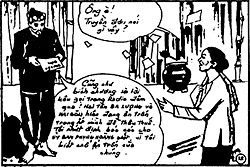
“Honey, what do they say in those leaflets?”
“They are the same as those wall posters, as well as the announcements on the radio yesterday. The two Communists Ba Luong and Hai Gon are presently hiding our village in order to collect taxes. I am determined to report to the Phoenix Operation Committee because I know their hiding place.”
We’ve seen the CIA use comics to fight the Sandinistas; the FBI to fight the Black Panther Party; and with the Comics Code Authority to portray the CIA, ethnic advancement agencies, and the economically privileged in a positive light for U.S. comics readers. The CIA also used comics during the Vietnam War as part of its psychological operations and counterinsurgency campaign.
The comic book, “Mr. Ba’s Family and the Phoenix Operation,” was prepared and disseminated by U.S. forces in South Viet Nam under Operation Phoenix. Operation Phoenix was designed to assassinate or imprison members and collaborators of the National Liberation Front, the united front that brought together Communists and non-Communists to liberate Viet Nam from foreign control.
“Phoenix offices were set up from Saigon down to the district level. Their functions were to: (1) collate intelligence about the ‘Vietcong Infrastructure’; (2) interrogate civilians picked up at random by military units carrying out sweeps through villages; (3) ‘neutralize’ targeted members of the NLF. This third task was often carried out by CIA-led Vietnamese organized into Provincial Reconnaissance Units.”
The comic the fictional story of “Mr. Ba,” who is conviced and eventually rewarded for informing the U.S. military about where the Viet Cong are hiding in his village.
Read more about the comic or See pages from the comic and an English translation. Note, the page and images load slowly.)
On July 19, 1971, William Colby, the CIA officer in charge of Operation Phoenix, testified before a Subcommittee of the House Committee on Government Operations, that between 1968 and May 1971, 20,587 alleged Vietcong sympathizers were executed as a result of the Phoenix Program. The government of South Vietnam credited Phoenix with 40,994 deaths. Vietnamese who were taken into custody were often tortured before being executed. U.S. military-intelligence officer, K. Barton Osborn testified that none of those ever held for questioning lived through the process. (New York Times, August 3, 1971, p. 10.)
The Memory Hole has posted a collection of CIA documents from the Phoenix Program online.
Anti-War Group Revives “Daisy” Ad Campaign, January 15, 2003
From AP:
“Revisiting one of the most effective television commercials in the annals of U.S. politics, a grassroots anti-war group has produced a remake of the ‘Daisy’ ad, warning that a war against Iraq could spark nuclear Armageddon.
The provocative 30-second commercial - released to the media Wednesday and appearing in 12 major U.S. cities on Thursday at a cost of $400,000, was prepared with the help of thousands of donations to the Internet-based group MoveOn.org.
 The original Daisy ad aired only once, during the 1964 presidential race. Produced by the campaign of incumbent Lyndon B. Johnson, it depicted a 6-year-old girl plucking petals from a daisy - along with a missile launch countdown and then a nuclear mushroom cloud. The suggestion was that if elected president, Republican Barry Goldwater might lead the United States to a nuclear war with the Soviet Union. Goldwater lost by a wide margin.
The original Daisy ad aired only once, during the 1964 presidential race. Produced by the campaign of incumbent Lyndon B. Johnson, it depicted a 6-year-old girl plucking petals from a daisy - along with a missile launch countdown and then a nuclear mushroom cloud. The suggestion was that if elected president, Republican Barry Goldwater might lead the United States to a nuclear war with the Soviet Union. Goldwater lost by a wide margin.
The 2003 version follows the same format, with an added montage of scenes of military escalation: burning oil wells, tanks in the battlefield, wounded soldiers, chaotic protests in a foreign city and an ambulance racing through U.S. streets. Then, a similar mushroom cloud, and the screen goes to black, with a dire warning: ‘War with Iraq. Maybe it will end quickly. Maybe not. Maybe it will spread. Maybe extremists will take over countries with nuclear weapons. Maybe the unthinkable.’
Then, another ‘10... 9... 8...,’ countdown, and a final message: ‘Maybe that’s why the overwhelming majority of Americans say to President Bush: let the inspections work.’
MoveOn.org’s leaders hope the ad will enliven the debate on the specter of war - and persuade Americans to oppose a military solution in Iraq.
‘We’re playing with matches in a tinderbox,’ Eli Pariser, MoveOn.org’s international campaign director said. ‘We wanted to run an ad that would highlight that very real possibility and help encourage a national discussion about the consequences of war.’”
MoveOn was started in 1998 by a couple of guys in Silicon Valley as an online petition encouraging Congress to resolve the long running investigation and impeachement proceedings of President Clinton. Their email list has since grown to 600,000 users, and the org now solicits contributions for its Political Action Committee, MoveOnPAC, whose campaign contributions “provide financial support to congressional candidates who embrace moderate to progressive principles of national government. Our intention is to encourage and facilitate smaller donations to offset the influence of wealthy and corporate donors.”
On the ad:
“In December, we asked members to contribute $27,000 for a print ad in the New York Times. Within days, we had more than $400,000 committed to our ad campaign. This allowed us to do several print ads, including an ad in USA Today. To follow up, we ran a radio ad created by Betsey Binet, one of our members. But once we saw the avalanche of support, we knew it was time to go to TV. Over the holidays, we worked on the spot you’ll see today. Our goal is to underline the risk of war and we’ve created a piece intended to provoke discussion and controversy....
The ad is airing on TV stations in Washington, DC, Los Angeles, San Francisco, Philadelphia, Chicago, Dallas, Miami, Boston, Minneapolis, Phoenix, Cleveland, Portland and Seattle. The ad buy is largely on cable networks, and will show heavily on public interest shows on channels such as CNN and MSNBC for the next week. At 10am today in each of these media markets, MoveOn volunteers will be running press conferences for the local media.”
A RealVideo version of the ad is up on their Web site.
It’s great to see the anti-war message breaking through the virtual ban on dissent in the mainstream media. I hope this will help create a space for the media to cover this weekend’s protests in D.C. and around the world.
The ad is also a good effort to try to show some of the consequences of the war on TV, but images of mushroom clouds don’t quite evoke the human cost for me. Cinematic explosions are pretty cheap these days. I suppose the zoom on the little white girl tries to do this by implication.
The message of the ad also seems a bit muddled. The ad urges Bush to “let the inspections work.” But then is it OK to go to war if the inspectons do in fact show Iraq in violation of UN resolutions? Wouldn’t the same costs apply if the U.S. attacked Iraq with the approval of the UN?
“Today, in Venezuela, the uniformed Armed Forces build housing and infrastructure. It’s interesting; one of the key demands of the ‘opposition’ is to prohibit the army from building houses! The poor cheer when the military enters their neighborhoods, because they’re usually coming to build some houses. Not, like before, when they came to round up the dissidents and repress the social movements.”
This interview on Indymedia prompted me to do a little googling.
President Chavez’s Plan Bolivar 2000 is part public works administration, part poverty reduction plan, part fight against corruption. Despite Venezuela’s immense oil reserves, 80% of the population lives in poverty. To execute the plan, Chavez brought in military officers to bypass civilian agencies he considered corrupt. The military are working with communities and civilian engineers to build and repair roads, schools, housing, and medical centers around the country.
Critics charge that the plan has just shifted the corruption to the military. Chavez has acknowledged incidents of corruption and has ordered the Auditor-General of the Republic to investigate. Other internal investigations have taken place, though are staffed by military officers investigating other military officers. In response to charges, Chavez announced he will reduce ‘secret’ military spending and that more expenditures will be made public.
I’m having a hard time finding data on the status of the project, but one Captain estimates that Bolivar 2000 has already rebuilt or refurbished some 4,000 schools, clinics and hospitals.
“Indonesia’s pulp and paper industry has rapidly expanded since the late 1980s to become one of the world’s top ten producers. But the industry has accumulated debts of more than U.S.$20 billion, and expanding demand consumes wide swathes of Sumatra’s lowland tropical forests. This land is claimed by indigenous communities, who depend on them for rice farming and rubber tapping. The loss of access to forests, together with companies, hiring from outside the province, has been devastating to local livelihoods, leading to violent conflicts.
Asia Pulp & Paper (APP) is Indonesia’s leading paper producer, and owner of one of the largest stand-alone pulp mills in the world, the Indah Kiat mill in Riau, Sumatra. The mill’s primary fiber supplier, Arara Abadi, established its pulpwood plantation in the 1980s-90s, under then President Soeharto. Arara Abadi, backed by state security forces, routinely seized land for the plantations from indigenous communities without due process and with little or no compensation.
Since the fall of Soeharto in May 1998, local residents have attempted to press their claims, but have met with unresponsive law enforcement. With no remedy for their grievances, communities have increasingly turned to vigilantism. Arara Abadi has responded with violence and arrests.
[In 2001] local villagers in Mandiangin, Betung, and Angkasa/Belam Merah... set up blockades or began logging plantation trees. Hundreds of club-wielding company militia attacked residents, seriously injuring nine and detaining sixty-three. Indonesian police, who trained the civilian militias and also were present during the attacks, were complicit....
The majority of police and military spending (70 percent) comes from off-budget business ventures, many of which are in the forestry sector. These business ties set up an economic conflict of interest in law enforcement. In addition, Arara Abadi’s security personnel have no guidelines for the use of force and are not held accountable for violations of the rights of local people.”
See Without Remedy: Human Rights Abuse and Indonesia’s Pulp and Paper Industry.
Though Human Rights Watch implicates funding by multilateral financial institutions like the World Bank and International Monetary Fund and places the paper industry in the context of foreign dept, they do not address the fact that APP’s assets (valued at US$ 17.5 billion) are largely financed by is shareholders (25%), bondholders (38%) and banks (20%). Many of the biggest investment banks and export credit agencies in the U.S., Europe, and Asia have provided loans and guaranteed this finance over the last ten years. Friends of the Earth names the names and lists UK distributors of APP Paper.
In South Korea, it’s the mouse that roars
New breed of politician taps the country’s love affair with high tech
“The winning candidate in last week’s South Korean presidential election had little need for mass rallies or traditional campaign tactics.
When Roh Moo-hyun’s organizers wanted supporters to vote on election day, they simply pressed a few computer keys. Text messages flashed to the cellphones of almost 800,000 people, urging them to go to the polls.
During his campaign, millions of voters absorbed Mr. Roh’s message from Internet sites that featured video clips of the candidate and audio broadcasts by disc jockeys and rock stars. Half a million visitors logged on to his main Web site every day to donate money or obtain campaign updates. More than 7,000 voters a day sent him e-mails with policy ideas. Internet chat groups buzzed with debate on the election....
Almost half of South Korean voters are below the age of 40 — a prime demographic for users of the Internet and cellphones. Until this year, many were apathetic politically, put off by the country’s traditional political machinery. But Mr. Roh reached out to voters with one of the world’s most sophisticated Internet campaigns, and the vast majority of the younger population voted for him.
Until a year ago, Mr. Roh was best known for his repeated failures to be elected to parliament. Self-educated, he came from a poor family and had been jailed for helping dissidents fight the military regimes of the past. But young voters admired the lawyer for his integrity and his image as an independent outsider, and they formed an Internet fan club to promote his future.
The Internet allowed Mr. Roh to liberate himself from ‘black money’ — corporate donations that are South Korea’s traditional form of campaign financing. Largely through Internet-based campaign groups, Mr. Roh raised the equivalent of about $1-billion from more than 180,000 individual donors.”
I’m impressed by the apparent influence of the grassroots fan club site. And 7,000 users a day sent the guy policy ideas? It will be interesting to see how President Roh fulfills his promise “to use the Internet to make the government more open and transparent.”
Otherwise, though tech angle is interesting, the article totally takes it out of context. Who else was running? What issues were being discussed? Mr. Roh’s popularity is not just due to his “repeated failures to be elected to parliament” but to the fact that he repeatedly chose to run in districts where he knew he would lose in order to make a statement about the regional election machine. Many Koreans vote for candidates based primarily on what district they are from. Mr. Roh’s campaign runs were a principled stand against this.
Mr. Roh’s popularity is also due to the fact that he was a leader in the pro-democracy movement against the dictatorship of Chun Doo-hwan, was imprisoned for his political activism, and has a solid record as an advocate of human rights. As a lawyer he could have chosen a much more lucrative career instead of defending labor unions, students, and the poor. And, unlike his political rivals, wants to engage more with North Korea. (See the BBC’s profile.)
The real shock of the election is that a liberal candidate was elected after decades of conservative rule. In the past, the three powerful conservative newspapers have pushed hard against liberal candidates, for instance playing up skirmishes in the DMZ around election time to scare voters away from liberal candidates who might not be as tough on the North. In Korea, the “liberal” label has even more sting than in the U.S. Being associated with Communism in the press could end your political career.
But the younger generation does it have the same relationship to the War or the military dictatorship as the older generation. And the under-30 crowd seems to have less aversion to leftist ideas or engagement with the North. The relevance of the Internet is part of the generational and ideological shift of the voting population in Korea.
In addition to a few facts about the Internet in Korea, the Globe article is a lot like typical U.S. election reporting. All tactics, no substance. Who displayed the most charisma? How much did they spend? Who endorsed them? Meanwhile, the chat rooms in Korea are buzzing with debate. I look forward to the day when the decentralized, online discussion is as influential as our mainstream election coverage.
page 1 2 3 4 5 6 7 8 9 10 11 12 13 14 15 16 17 18 19 20 21 22 23 24 25 26 27 28 29 30 31 32 33 34 35 36 37 38 39 40 41 42 43 44 45 46 47 48 49 50 51 52 53 54 55 56 57 58 59 60 61 62 63 64 65 66 67 68 69 70 71 72 73 74 75 76 77 78 79 80 81 82 83 84 85 86 87 88 89 90 91 92 93 94 95 96 97 98 99 100 101 102 103 104 105 106 107 108 109 110 111 112 113 114 115 116 117 118 119 120 121 122 123 124 125 126 127 128 129 130 131 132 133 134 135 136 137 138 139 140 141 142 143 144 145 146 147 148 149 150 151 152 153 154 155 156 157 158 159 160 161 162 163 164 165 166 167 168 169 170 171 172 173 174 175 176 177 178 179 180 181 182 183 184 185 186 187 188 189 190 191 192 193 194 195 196 197 198 199 200 201 202 203 204 205 206 207 208 209 210 211 212 213 214 215 216 217 218 219 220 221 222 223 224 225 226 227 228 229 230 231 232 233 234 235 236 237 238 239 240 241 242 243 244 245 246 247 248 249 250 251 252 253 254 255 256 257 258 259 260 261 262 263 264 265 266 267 268 269 270 271 272 273 274 275 276 277 278 279 280 281 282 283 284 285 286 287 288 289 290 291 292 293 294 295 296 297 298 299 300 301 302 303 304 305
[ Back ]
[ Next ]



